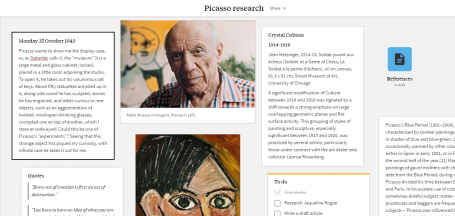I am personally a big fan of the Getting Things Done (GTD) System, and I have been an avid user for the past eight years. During that time I have used a lot of productivity systems and apps over the years to help me work with this system, and I have always come back to Trello because it is so adaptable and works so well with GTD. The GTD System, in a nutshell, is basically a system of organization that helps you collect and organize all those ideas, projects, and to-dos circling around inside your head. With GTD, you have a trusted system in place to get everything down on paper so that you can finally spend more of your time focusing your attention on the things that are important rather than worrying about something you might have missed or forgotten. Here are some tips and ideas on how I customized Trello to work with the GTD system. I hope that these ideas work for you:
Inbox
I keep an Inbox List on my Next Actions Board in Trello to collect my ideas, it’s simpler, and makes things easier to move to my actionable lists. I used to have a separate Inbox board in the past, but it got to be way too complicated. A simple inbox list should do nicely.
Next Actions
Here I have my items listed on this board based on status. I find that this system works best for Trello. Because you can easily move tasks in order on a list based on the order they need to get done, and you can always move tasks forward or behind if you need to.

To organize your tasks, I would recommend tags or stickers. For example, I use tags to designate contexts in my Next Actions list like home, errands, web, etc. This way I can visually group and organize tasks in a list based on their context and get them all done at once.

Someday/Maybe
One of the lists that I keep with my next actions is the Someday/Maybe list. I keep those items there and review them regularly before I move them to either my projects list or my Next Actions list.
Tickler File
For upcoming events, or tasks that need to be done I assign a card with a due date or assign the card to me. In order to see notifications for this card, I click the “Subscribe” option located in the right side bar menu on the board. This notifies me of any updates that I made to the board and any cards associated with that board. Very handy for status updates. When I want to see what tasks need to be done, I select my username, then cards. From here I can choose to sort the cards based on due date, or the board they are associated with. By linking my Trello board to Google Calendar, I can always get a reminder when an item is due, and thanks to the recent Google Inbox integration, it is also easy to see and pin all the reminders from Trello that need to be done.
Projects
I keep a Project Board for all my projects. Because most of the projects that I have to do are relatively small in nature I usually just create a card with a checklist of the tasks that need to get done. These are all assigned to lists on my project board, which I have divided into general categories like home, family, finances, personal, health, etc.
When I am ready to assign a task to be done, I open the project card and look at my checklist of to-dos. I select the checklist item, and copy it, then I select the option to convert the item to a card. From here, I select and copy the card link, then close that card and open the new card that I just created on my list.
In the description, I paste the project card link and save it, then I move the card to my next actions list for processing. This enables me always to refer back to the original project card when I am working so I can check my progress.
If you prefer seeing all your completed tasks, you can always copy and paste the task back into the checklist and mark it as complete, that way you know it has been processed, but either way, it’s up to you.
Bottom Line
There are a lot of other things that you can do in Trello too besides task management. Because Trello is such a simple and easy to understand system, anyone can use it. You can customize Trello to suit whatever format you would like. From your daily to-do lists, to meal planning, or just jotting down and to even creating your own blog like you see here. Your options are pretty much unlimited. If you are lost and don’t know where to start there are also a lot of great templates to choose from here. Everything can be shared by other members of your team or family, and you can easily attach images or documents, or link to your favorite cloud storage provider like Dropbox or Google Drive. And It all syncs in real-time across all your devices. Really, what’s not to love about Trello?

